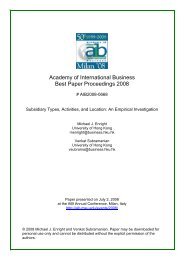AIB 2012 Conference Proceedings - Academy of International ...
AIB 2012 Conference Proceedings - Academy of International ...
AIB 2012 Conference Proceedings - Academy of International ...
Create successful ePaper yourself
Turn your PDF publications into a flip-book with our unique Google optimized e-Paper software.
TUESDAY<br />
innovation while other routines become critical at a later stage. Differences in effectiveness <strong>of</strong> AC routines and<br />
underlying mechanisms in turn can be traced back to organizational antecedents and to individual actors<br />
involved in the implementation <strong>of</strong> the innovation. (For more information, please contact: Carine Peeters,<br />
Université libre de Bruxelles, Belgium: carine.peeters@ulb.ac.be)<br />
The Global Co-Evolution <strong>of</strong> Firm Boundaries: Commoditization, Capabilities, and Paths Dependencies<br />
Stephan Manning, University <strong>of</strong> Massachusetts Boston<br />
Silvia Massini, University <strong>of</strong> Manchester<br />
Carine Peeters, Université libre de Bruxelles<br />
Arie Y. Lewin, Duke University<br />
This paper contributes to the discourse on the co-evolution <strong>of</strong> firm boundaries and capabilities by focusing on<br />
the impact <strong>of</strong> process commoditization, changing external availability <strong>of</strong> capabilities and firm specific paths <strong>of</strong><br />
governance decisions on the configuration <strong>of</strong> firm boundaries, and their co-evolution over time. Our analysis<br />
further incorporates the role <strong>of</strong> firm strategic orientation in decisions to source business services internally<br />
(captive) vs. from third party providers. We test our hypotheses on a unique and comprehensive panel <strong>of</strong> 930<br />
discrete <strong>of</strong>fshore operations across various business functions and locations from early experiments in the late<br />
1980s through 2011. Our empirical findings suggest that the three mechanisms <strong>of</strong> process commoditization,<br />
changing availability <strong>of</strong> service suppliers, firm-level experiences and prior sourcing decisions, along with<br />
strategic orientations, affect choices <strong>of</strong> governance models for sourcing particular tasks and, hence, the coevolution<br />
<strong>of</strong> firm boundaries in the context <strong>of</strong> global services sourcing. Yet, these three mechanisms affect<br />
governance model choices in different ways over time, which can be explained by the interplay <strong>of</strong> external<br />
dynamics (e.g. growing maturity <strong>of</strong> sourcing practices and supplier relations across firms) and internal dynamics<br />
(e.g. growing firm-level experience with and development <strong>of</strong> specific capabilities for global sourcing). (For more<br />
information, please contact: Stephan Manning, University <strong>of</strong> Massachusetts Boston, USA:<br />
stephan.manning@umb.edu)<br />
Session: 3.4.6 - Competitive<br />
Track: 3 - IB Theory, FDI, and Entry Mode<br />
Spillovers: Here, There, Everywhere<br />
Presented On: July 3, <strong>2012</strong> - 14:30-15:45<br />
Chair: Ulf Andersson, Copenhagen Business School<br />
Inter-regional Determinants <strong>of</strong> Innovatory Spillovers from Foreign Direct Investment: Evidence from China<br />
Yi (Elizabeth) Wang, University <strong>of</strong> Leeds<br />
Jeremy Clegg, University <strong>of</strong> Leeds<br />
Chengqi Wang, Nottingham University Business School<br />
This paper investigates the inter-regional impact <strong>of</strong> inward foreign direct investment (FDI) on the ability <strong>of</strong><br />
domestic Chinese firms to generate their own technologies. Research on FDI spillovers productivity effects<br />
argues that advanced technology employed by foreign-invested firms is adopted by domestically-owned firms,<br />
so raising their productivity. We know far less about the mechanisms through which FDI impacts upon the<br />
innovative capabilities <strong>of</strong> these domestic firms. We draw upon literatures on the multinational enterprises,<br />
knowledge diffusion (organisational learning), and economic geography to investigate empirically the<br />
relationship between inward FDI and domestic patent innovation (innovatory spillovers), and how and why this<br />
relationship varies spatially. We find that the baseline impact <strong>of</strong> innovatory spillovers is negative, in contrast<br />
with that generally found for productivity spillovers; patenting by foreign firms within the host economy<br />
perforce generates a near-perfect crowding out effect. We then identify an "inventing around" mechanism,<br />
<strong>AIB</strong> <strong>2012</strong> <strong>Conference</strong> <strong>Proceedings</strong><br />
Page 250

















